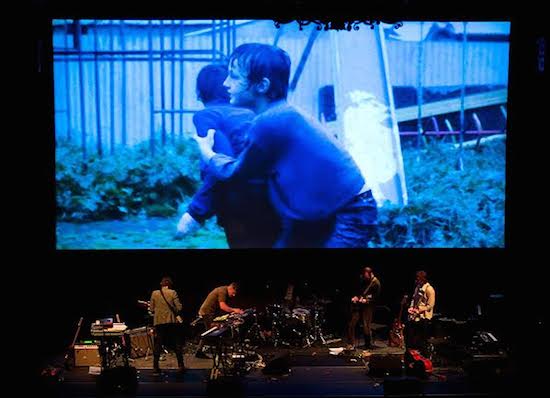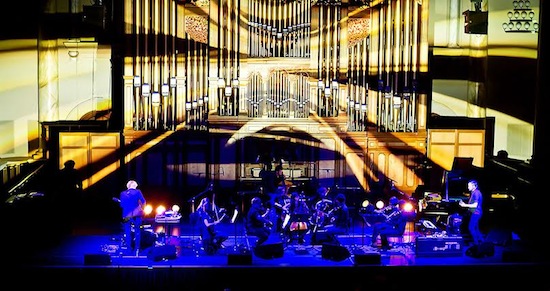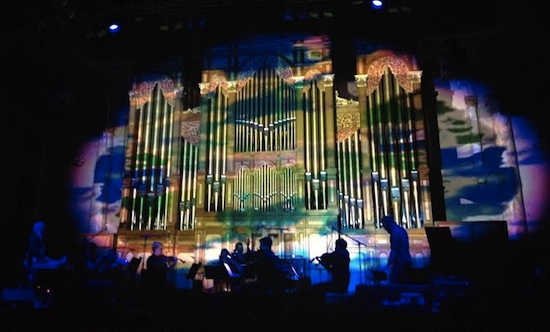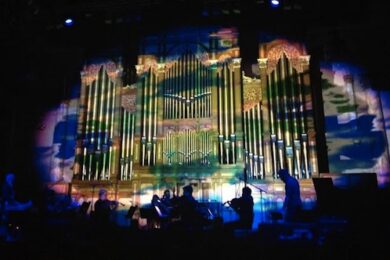March festival season in Adelaide is a time when a city often scorned for its dullness alights with culture. This year is Unsound’s second showing, a festival with its name in Europe but its roots in Wagga Wagga, a country town 900 kilometres west of Adelaide across the Shire of Bland and through the Murrumbidgee Irrigation Area ("the MIA").
Co-founder Mat Schulz grew up in Wagga Wagga where Unsound began. He re-started the festival in 2003 in Krakow and, a decade on, its events have spread to London, Minsk and New York. Now, thanks to the affinity of vision between Schulz and Adelaide Festival’s artistic director David Sefton, Unsound may become a permanent fixture in the city’s comfortably funded flagship event. Maybe in a few years it’ll be "our Nicole", "our Kylie", "our Russ" and "our Mat". Australians are fond of their tall poppies coming home stamped with foreign validation.
If you bring a European festival to Australia, open it with a local work
Walking to the Art Gallery of South Australia I realise Adelaide light is not buttery like Sydney’s but sharp and silvery like Tasmania’s and, though I’ve flown from city to city and I can’t see it, I can feel it: vast empty space is near and spans upwards to the bright high sky. At the gallery – stately and sandstone though not steepled like so many buildings in Australia’s "city of churches" – a local friend recalls her family holidays to Port Lincoln as a kid. "It was endless around there. It was frightening."
In 1999, eight bodies were found in barrels in an unused Snowtown bank vault. The victims had been tortured and murdered in the seven years preceding. The Kurzel family grew up close by and in 2011 Justin Kurzel’s debut feature Snowtown was released – produced by Warp Films. His brother Jed composed the score.
With the exception of one unwatchable scene ("you’ll know it when you see it," a friend warned me) the film’s most disturbing aspect is not the violence but how its open spaces feel closed and how trapped its characters seem within them. They are unpinned from social structures but do not seem free, not even willfully, dangerously free. From the opening frame their fate seems swallowed up by an unpreventable outcome – a common sensation in films based on true stories where the grim end is foretold – but in Snowtown, particularly, all exits appear sealed.
Snowtown: Live is Unsound Adelaide’s only local flavour. Obviously, the murders are not a proud topic for Adelaideans but where better to premiere this show than the city’s stuffy-spirited Town Hall, a place where you imagine serious-minded law-makers have beavered away for centuries on matters of public policy.
The show consists of unreleased footage edited into a dream-like sequence as a five-piece band expands on ideas previously pruned back for the soundtrack. It begins with the score’s most memorable motif: an ebbing thump that is both resolute and scared stiff, like a fast-beating heart before a terrible act. It heralds the arrival of something bad but, as it fades, also marks the passing of any chance to stop it. It is the sound of inevitability.
Some of the footage is remarkable. Do all directors squirrel away so much of worth? It depicts the same entrenched neglect as the film: derelict backyards, shopping trolleys full of rubbish and kids who look wise beyond their years in all the wrong ways. Miserable rain drips from gutters. Swings hang. Grass shudders. A merry-go-round spins in the rain, too fast for the kids to get on or off without getting hurt. The water seems to be washing them away and it ends in a smear of ascending colour. Like the film, the outtakes are hued thin bloodless-blue as though in perpetual dawn. A cold has seeped into the bones of the place and it can’t get warm again.
For the audience, the rules of engagement are left undrawn. Should we watch and let the sound seep in, as we would a film? Listen and let the visuals complement the music? Or observe the tenseness of the partly improvising band as their eyes follow Kurzel? Probably, we should just let it all swirl subliminally together but I dart fitfully from one medium to another, unable to settle. The best moments are when I have no choice because the elements combine so seamlessly and forcefully. A weirdly harrowing close-up of a snake swallowing a mouse is one such moment, as is a boy cross-dressing before a mirror to a kind of post-rock soar. The most powerful metaphor, however, is an outtake too subjective for a filmmaker to use: fingers splayed messily over the camera’s lens, obscuring our view. You don’t want to see this, it implores. Don’t look. Turn away.

You never really know what’s happening up the back
Assuming all Stars Of The Lid’s moving parts are oiled and in good working order (elegant venue, exceptional acoustics, interesting surface for projections and a worship-y crowd) the trio (third member being visual designer Luke Savisky) could only disappoint their long-term fans if they did something in maniacally poor taste. Like tell a racist joke and guffaw at it. Or fart into a microphone. None of these things happen of course. The show goes through all the glorious motions: peaceful, graceful and occasionally soaring into unutterable sadness.
I’m not up for any surprises. So when Brian McBride tells me Stars Of The Lid "work around" the unanticipated timings of the string sections they play with live, and Jed Kurzel tells me musicians should be "hanging on for dear life", and Trent Reznor tells someone else his current show is "much less rehearsed", I secretly hope not too much spontaneity is planned for tonight because, really, I’d rather it progressed with all the impervious cosmic predictability of Titan orbiting Saturn.
The spectacle is stunning. "I told them to take the screen down," Savisky tells me later, so his visuals are projected on the pipe organ that looms heavenwards behind the Town Hall stage, its golden spears mottled by a glide of seashine-y light. The eight-piece string section sits serenely between Adam Wiltzie stage right and McBride stage left and, just as you would hope, the first sound is the violinists drawing their bows in one long slow motion, the sustain of which is submersed into the band’s trademark celestial drone.
Posturing is important. Apropos of little, Wiltzie will strike what looks like a power chord but what sounds like nothing at all. For about 30 seconds he plays a grand piano that probably cost Adelaide Festival the equivalent of a teacher’s annual salary to source and lug in here. Perhaps he plays it for 60 seconds, maybe two minutes – five? Stars Of The Lid make clocking time blissfully yet bloody difficult, as what might otherwise be short moments go on oh so long. There is an actual crescendo – all sawing elbows and bows in angular disarray – that blossoms into the safest, softest explosion of volume I’ve heard.
The audience, however, is split. 98% here are misty-eyed putty in the band’s hands but 2% are (two) wretchedly drunk blokes up the back who hate the band, refuse to be graciously won over and don’t know how loud their derisive whispers are, or that a rage is at first simmering and then boiling over furiously in a guy nearby who turns, stands and booms at them: "Why don’t you two go outside and suck each other’s cocks?"
Oh, for an exit survey of the Stars Of The Lid fans ejected from their extraterrestrial reveries by that horrid exchange. Fortunately, the only thing heard down my end of town (Hall) are the creaks and cotton-y slidings of people trying to recline another millimetre or two in their straight-backed chairs. Stars Of The Lid may claim they are not "heroes of the drowsy" but, in fact, they are exactly that, yet it is all glory and no shame to command music that is so powerfully soporific.
It’s the little things
Unsound moves for its two final nights to Queen’s Theatre on Playhouse Lane. Town Hall works for Thursday but I wouldn’t want to spend my weekend sidling by the brass bosom of Queen Adelaide in its brightly lit foyer every time a ciggie break was due.
Queen’s Theatre is not royal at all. Every wall, bench, curtain and cranny is black and even when the screens pulse with light you can find a corner to get dark in. It’s sold out but there is still plenty of roaming room. The bar is separate so the boozing chatterers can only irritate each other. And up the back, for the weary, are tiered benches with excellent sightlines and on those benches is foam to cushion the weight of their weary arses.
Best of all? The sound is great for every act and, really, that can’t be easy. I meet last year’s Unsound soundie who talks about sound like it’s a sentient over-watered lawn trying to avoid a Saturday morning whipper-snippering. "Bass builds up in the corners. You need to clean it up and keep it neat, tidy and evenly spread."
The corners, then, cop a flogging when Emptyset play a set that elicits Stockholm Syndrome-style worship by a crowd that is clearly ready to be held captive to something brutally, destructively danceable. The pummelling of bass tickles my nostrils and itches my ears but is so expertly wielded by the Bristol duo that I feel quite safe in their machine gun-blast of mayhem.
A little bit of attitude goes a long way
"We could run a whole festival of just the people who cancelled on us!" David Sefton says a week. Last year’s pikers included The Caretaker (ear infection – couldn’t fly), Emeralds (broke up – couldn’t wait) and this year, The Haxan Cloak (big continent – small scene – Adelaide too far to wing it without a bunch of other shows booked).
The abstracted techno of The Haxan Cloak’s replacement, Lee Gamble, surfaces familiar tropes then submerges them into foreign ones… but also frustrates in that nothing overwhelms. That’s until Gamble breaks the ice indeed when two long plush notes precede an abrasive tearing crunch, like a massive sheet of ice cleaving off an Antarctic shelf, crashing and splintering below; beginning the final mass melt. Bells clang, bass snarls, people whip out earplugs, a galloping beat takes over like the first post-Apocalyptic steed and I think: "This is why I came."
It closes with some four to the floor techno before Gamble slams his laptop lid shut.
What would Femi Kuti do?
William Bennett’s bold and permissive set as Cut Hands doesn’t quite manage to get the room dancing but it shakes things out and loosens things up and sets bodies free of brains to move without thought. Though clearly Bennett reckons we still need a prod. He’s busier than us – all we’re doing is perving on the naked Bond girl-esque silhouettes dancing sexily on the screen – but he spares a moment to give us a demo on how it’s done. Like this (a twirl) or like this (gyrates with hands behind head) take it away guys! But everyone just cheers at him instead.
Friend: "What’s that alarm sound?"
Me: "Cut Hands!"
Friend: "I don’t think so…"
Me: "Really?"
Bennett’s set moves into the percussive over-stimulus of the Afro Noise cuts (though I swear he’s snuck in an off-continent sample of those tiny Turkish finger cymbals). The screens flare with African booties, boobs and lots of cool-looking voodoo stuff chopped up and strobed at us in increasingly feverish flashes. Some of his drums sound massive – and by that, I mean literally massive bass drums – and I end up in the bleachers, eyes closed, imagining what taut-skinned beauties you could never smuggle through Australian customs are mashed up in his mix. Femi Kuti’s in town. I wonder what he’d think of all this?

The truth usually lies somewhere in the middle
One friend puts James Ferraro’s set as such: "He opened up his suitcase / There was blue fog / Everyone stood around for a while." Another, later, says: "It was crisp pop music that’s wilted on prolonged exposure to the internet’s variegated stimuli."
It’s impossible to predict if octogenarian Morton Subotnick playing his 1967 album Silver Apples Of The Moon (the first electronic work commissioned by a record label) will impress as an artefact or purely on its own merits. Will the snowy-haired Subotnick’s twiddlings on a Bulcha synthesiser only thrill the analogue gear-heads? Would the piece sound as good were it played by a po-faced guy in a hoodie squinting down at a MacBook?
Played in crystalline surround sound to a pin-drop quiet crowd, Subotnick’s piece is a revelation. Antiquated-sounding, yes, in all the bleepy ways you might imagine, but in the ample space between the hisses, squelches, beepings and harmonic washes is a presence that died out as our grip of technology grew more alive: a sense that the man/machine scales are evenly weighed and that despite the electronic composer’s darnedest efforts, machines were still erupting with their own untamed utterances.
For Subotnick, the audience is on its best behaviour and this is a well-behaved crowd at the worst of times. People stand at respectful distances to each other, heads arched, listening intently. The last part of Silver Apples is the best: melodic droplets bubbling down all around us. After the show, a shared elation is felt and strangers meet strangers and talk about Subotnick.
iTunes Genius is unavailable for the song ‘Musical Bovine Spongiform’
For the first time, people in the crowd ditch their self-effacing equidistance and form a tight, committed knot before the stage. Nurse With Wound’s show is why many are here. "I’ve been listening to Soliloquy for Lilith five nights a week since 1990," a guy tells me rather solemnly. He doesn’t say every night so I actually believe him.
A table runs the length of the stage, sagging with gear and on the screen a ticker counts down. "Live it is always improvisation and I have very little control over the direction of it," Stephen Stapleton told Absinthe.com.au a week before. "We have guests… usually people I meet an hour or the day before… a performance artist, poet or juggler or whatever and they usually end up on stage with us." We are spared the poet and the juggler because Hungarian black metal vocalist Attila Csihar (Mayhem, Sunn O))), etc) is in town. Csihar is here for a Gravetemple gig a few days later and, as it happens, idolises Nurse With Wound. Thus, in a confab twenty minutes before the show (a whip-tight turnaround, even by Stapleton’s standards), it is settled: Csihar will guest.
As the Nurse With Wound trio of Stapleton, Colin Potter and Andrew Liles begin to erect the Nurse With Wound sound monolith – Stapleton labouring over what could be a pepper grinder and Liles playing recorder – Csihar begins to zombie-walk from stage left, en route to delivering a "you had to fucking be there man" performance of terrifying charisma, his gasping screeches inhaling us into the bowels of the NWW psychic innards; a kind of nihilistic bonfire where Victorian-era armchairs hurtle down cliffs, mattresses levitate from paddocks, house-dwellers flick flames from their clothes in a kind of sinister somnambulist apathy, and a couple sleep peacefully wrapped in slabs of raw meat: all of it seemingly beamed to the screens directly from someone else’s nightmare. Meanwhile, the Nurse With Wound labour, Potter in particular not bothering to mask the anxious intensity of creating music that, while it is obviously improvised, also feels entirely impenetrable.
From Csihar’s Blixa Bargeld-esque screeches to his ghoulish throat-sung glossolalia – all of which is processed by the nurses into something ever more fearful – comes a genuine sense we’re signing off on a contract of some nameless ritualistic evil. Finally, Csihar turns, raises his arms, hallows the trio, then lurches off. A great grim wall of noise is raised and at some point in the disorienting melee, a guitar appears slung across Liles’ chest on which he plays some brutally distorted power chords, causing a few relieved smiles of recognition to pass across people’s faces.



